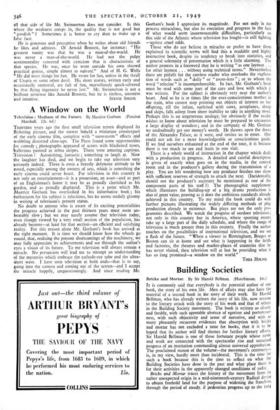A Window on the World
TIIIRTEEN years ago the first small television screen displayed its flickering picture, and the viewer beheld a miniature counterpart of the early cinema film, complete with "snowstorm" effects and wobbling distorted close-ups. The Press found some opportunities for comedy ; photographs appeared of actors with blackened noses, !ballerinas painted in zebra stripes. There were amusing captions. Television I Astonishing, fantastic ; something to laugh at. Now the laughter has died, and we begin to take our television very 'seriously indeed. There is even a fiercely defensive attitude to be noted, especially among the owners of sets, which is something the early cinema could never boast. For television in this country is not only an entertainment—it is a possession, an asset—and as part of an Englishman's home it may be as proudly cherished as his garden, and as proudly displayed. This is a point which Mr. • urice Gorham has overlooked in his informative book ; his enthusiasm for his subject is infectious, but he seems unduly gloomy in writing of television's present status.
No doubt to anyone who is aware of its exciting potentialities the progress achieved in the past thirteen years must seem un- bearably slow ; but we may surely assume that television today, even though viewed by a very small section of the population, has already become—at least for that section—an efficient and satisfying reality. For this reason alone Mr. Gorham's book has arrived at the right moment. It is time we should know how the wheels go round, that, realising the present shortcomings of the machinery, we may fully appreciate its achievements and see through the author's eyes a vision of its future. To me television will always remain a miracle. No persuasion will lead me to attempt an understanding of the mysteries which embrace the cathode-ray tube and the ultra- short wave. I have seen television at both ends—that is to say, going into the camera and coming out of the screen—and I accept the miracle happily, unquestioningly. And since reading Mr.
Gorham's book I appreciate its magnitude. For not only is the process miraculous, but also its execution and progress in the face of what would seem insurmountable difficulties, particularly on this side of the Atlantic where television has fought—is still fighting —against cruel odds.
Those who do not believe in miracles or prefer to have them explained in scientific terms will find this a readable and highly instructive book, despite its tendency to break into statistics, and a general solemnity of presentation which is a little alarming. The author protests in a foreword that he is writing "as one layman ... for other laymen . . . without using technical terms." Nevertheles, there are pitfalls for the careless reader who overlooks the explana- tion of words such as 4 dolly" or " zoom-lens" • or to whom the word " telecine" is incomprehensible. In fact, Mr. Gorham's book must be read with some part of the care and love with which it was written. For the subject is obviously very near the author's heart. And so he is at times like the over-conscientious mother in the train, who cannot stop pointing out objects of interest .to her offspring, tin the infant, surfeited with cows, aeroplanes, sheep and ships, falls asleep from sheer inability to take in anything more. Perhaps this is an ungenerous analogy,lor obviously if the reader wishes to know about television he must be prepared to encounter a large display of wonders-; and in the company of Mr. Gorham we undoubtedly get our money's worth. He throws open the doors of the Alexandra Palace, as it were, and invites us to enter. One could not ask for a more knowledgeable or conscientious guide. If we find ourselves exhausted at the end of the tour, it is because there is too much to see and learn in one visit.
There is a whole world of instruction in the chapter which deals with a production in progress. A detailed and careful description is given of exactly what goes on in the studio, in the control room and in the producer's gallery during the transmission of a play. You are left wondering how any producer finishes one show with sufficient reserves of strength to attack the next. (Incidentally, should not the producer's secretary be mentioned as one of the component parts of his staff ?) The photographic supplement which illustrates the building-up of a big drama production is also of great value, proving as it does the ambitious standards already achieved in this country. To my mind the book could do with further pictures illustrating the widely differing methods of play production already in existence. But plays are not the only pro- grammes described. We watch the progress of outdoor television; not only in this country but in America, where sporting events• take up a large part of the daily schedule, and where the range of television is much greater than in this country. Finally the author touches on the possibilities of international television, and we see a flash of the future. "When a viewer in Birmingham, Bruges or Boston can sit at home and see what is happening in the fields and factories, the theatres and market-places of countries that he has never visited, then television will at last be providing what it has so long promised--a window on the world."
THEA HOLM.


































 Previous page
Previous page